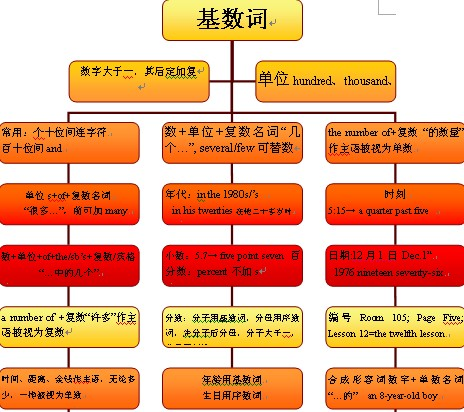本试题 “The buildings were completely ______ by the torrent (洪流) of mud and rocks and ______ people hadto live in the shelters put up by the PLA men.A. d...” 主要考查您对基数词
动词
等考点的理解。关于这些考点您可以点击下面的选项卡查看详细档案。
- 基数词
- 动词
基数词的概念:
数词是指表示数目多少或顺序先后的词。表示数目多少的数词叫基数词,如one, five, ten, thirty, sixty-five等,数词与不定代词用法相似,在现代英语中,它与不定代词、冠词、指示代词、形容词性物主代词等被称之为限定词。数词用法相当于名词和形容词,在句中可用作主语、宾语、表语、定语、同位语等。
时刻的表示法:
①若为整点钟,则直接读相应的基数词;若为非整点钟,则分别以“时”和“分”为单位用相应的基数词读出:
如:twelve (12),
eight twenty (8:20),
nine forty-five (9:45)
②对于带“分”的时间,也可借助past(过)和to(差)这两个介词来表示(在美国英语中用after表示“过”)。
注:这样表示时“分”不能超过30,否则应作处理,如9.38应处理成“10点差22分”:
如:9.18 eighteen minutes past(after)nine(=nine eighteen)
10.46 fourteen minutes to eleven(=ten forty-six)
以上分钟后带了minutes一词。若“分”为5,10,15,20等五的倍数,则可省略minutes:
如:8.05 five(minutes)past[after]eight(=eight five)
9.20 twenty(minutes)past[after]nine(=nine twenty) 若“分”为15或45,可借用quarter一词;若“分”为30,可借用half一词:
如:6.15 a quarter past six
8.45 a quarter to nine
10.30 half past ten
注:时刻表示法分为12小时编时制和24小时编时制。
日期的表示法:
日期的写法(书面语)和读法(口语)稍有不同,如“十月一日”可以写成October1, October 1st, 1October, 1st October, (the)1st of October 等,表示月份的词也可用缩略式,如Oct.1, 1Oct.1,但是在口语中通常只有两种读法October(the)first或the first of October。
注:日期与星期排列时,通常是星期在前,日期在后:
如:He arrived on Friday, May10. 他于5月10日(星期五)到达。
年份的表示法:
通常以“百”为单位来读。如1986年通常读作nineteen(hundredand)eighty-six,除非在正式场合,其中的hundred and通常都省,但在通常情况下不能按普通基数词的读法那样读成one thousand nine hundred and eighty-six。不过,像1500这样的年份可以有两种读法one thousand five hundred和fifteen hundred,而2000年通常读作two thousand,2003年读作two thousand and three。若表示某个某个年代,则按类似以下的读法:1980s读作nineteen-eighties(20世纪80年代),1600s读作sixteen hundreds(17世纪头10年,即1600—1610),比较:1300 thirteen hundred(1300年)。
基数词的表示法:
(1)以下是最基本的基数词:
one(1), two(2), three(3), four(4), five(5), six(6), seven(7), eight(8), nine(9), ten(10),
eleven(11), twelve(12), thirteen(13), fourteen(14), fifteen(15), sixteen(16), seventeen(17), eighteen(18), nineteen(19),
twenty(20), thirty(30), forty(40), fifty(50), sixty(60), seventy(70), eighty(80), ninety(90), a hundred(100), a thousand(1000), a million(1000000), a billion(十亿)
(2)21—99的表示法。先说“几十”,再说“几”,中间加连字号:
如:twenty-one(21),
thirty-six(36),
forty-five(45),
ninety-nine(99)等。
(3)101—999的表示法。先说“几百”,后接and,再加末尾两位数(或末位数):
如:one hundred and one(101),
five hundred and thirty(530),
seventy hundred and eighty-nine(789)
(4)1000以上的基数词的表示法。先从右至左数,每三位数加一个逗号(即以此把数目分为若干段)。
第一个逗号前的数为thousand(千),第二个逗号前的数million(百万),第三个逗号前的数为billion(十亿),第四个逗号前的数为trillion(万亿),然后一段一段地数:
如:9,883 nine thousand, eigh thundred and eighty-three
65,359 sixty-five thousand, three hundred and fifty-nine
265,468 two hundred and sixty-five thousand, four hundred and sixty-eight
60,263,150 sixty million, two hundred and sixty-three thousand,one hundred and fifty
注:①英语没有“万”这个单位,要表示“万”须借用thousand,如“一万”用“十千”表示(ten thousand),“十万”用“百千”表示(one hundred thousand)。
②hundred, thousand, million, billion等词在读数时不带复数词尾-s(即用单数形式)。
③在hundred后通常加上连词,不过此and在美国英语中可以省略。若读数中没有hundred,则在thousand后加and。
④一个数的最高位若为“一”,这个“一”可用a或one表示,但在数字中间的“一”,则只能用one,不能用a:
如:1600a[one]thousand and six hundred
6100 six thousand and one hundred (其中的one不可改为a)
⑤在非正式场合,人们也常以hundred为单位来读数
如:It cost fifteen hundred pounds. 这东西花了1500英镑。
基数词知识体系:

用于复数形式的基数词:
(1)表示整十的基数词用复数形式可以表示人的岁数或年代:
如:in the sixties 在60年代
in one's thirties 在某人30多岁时
(2)基数词转化为名词,可用复数形式:
如:How many twos are there in ten? 10里面有几个2?
Thesoldiersmarchedintens.士兵们10人一排前进。
(3)某些习语中也用复数形式的基数词:
如:in[by] twos and threes 三三两两地
at sixes and sevens 乱其八糟
表示倍数的基数词:
1、倍数+as +形容词/副词(原级)+ as+比较对象。
如: 这座桥是那座桥的三倍长。
This bridge is three times as long as that one.
2. 倍数+形容词或副词的比较级+than+比较对象。
如:这座桥是那座桥的三倍长。
This bridge is three times longer than that one.
3. 倍数+ the size/length/weight…+of+表示比较对象的名词。
如:这座桥是那座桥的三倍长。
This bridge is three times the length of that one.
动词的定义:
表示动作中状态的词叫做动词。根据其在句中的功能,动词可分为行为动词、系动词、助动词和情态动词四类,有些动词是兼类词。
例如:We have lunch at 12. (have是行为动词)
We have been to NewYork. (have是助动词)
I am hungry. (am是系动词)
You need not have waited for me. (need是情态动词)
The door needs painting. (need是兼类词)
动词的分类:
1)表示动作中状态的词叫做动词。
2)根据其在句中的功能,动词可分为四类,分别是:
实义动词(Notional Verb)、系动词(Link Verb)、助动词(Auxiliary Verb)、情态动词(Modal Verb)。
说明:有些情况下,有些动词是兼类词。
例如:We are having a meeting. 我们正在开会。(having是实义动词。)
He has gone to NewYork.他已去纽约。(has是助动词。)
3)动词根据其后是否带有宾语,可分为两类,分别是:
及物动词(Transitive Verb)、不及物动词(Intransitive Verb),缩写形式分别为vt.和vi.。
说明:同一动词有时可用作及物动词,有时可用作不及物动词。
例如:She can dance and sing. 她能唱歌又能跳舞。(sing在此用作不及物动词。)
She can sing many English songs. 她能唱好多首英文歌曲。(sing用作及物动词。)
4)根据是否受主语的人称和数的限制,可分两类,分别是:
限定动词(Finite Verb)、非限定动词(Non-finite Verb)。
例如:She sings very well. 她唱得很好。(sing受主语she的限制,故用第三人称单数形式sings。)
She wants to learn English well. 她想学好英语。(to learn不受主语she的限制,没有词形变化,是非限定动词。
说明:英语中共有三种非限定动词,分别是:动词不定式(Infinitive)、动名词(Gerund)、分词(Participle)。
5)根据动词的组成形式,可分为三类,分别是:
单字词(One-Word Verb)、短语动词(Phrasal Verb)、动词短语(Verbal Phrase)
例如:The English language contains many phrasal verbs and verbal phrases. 英语里有许多短语动词和动词短语。(contains是单字动词。)
Students should learn to look up new words in dictionaries. 学生们学会查字典。(look up是短语动词。)
The young ought to take care of the old. 年轻人应照料老人。(takecareof是动词短语。)
6)动词有五种形态,分别是:
原形(OriginalForm)、第三人称单数形式(Singular From in Third Personal)、过去式(Past Form)、过去分词(Past Participle)、现在分词(Present Participle)。
动词知识体系:

与“The buildings were completely ______ by the torrent (洪流...”考查相似的试题有:
- The shoe was discovered on the Chilkoot Pass, the famous trail used by people ______ gold in Alaska. A.lookingB.fin...
- —Why is he feeling disappointed today?—Because the suggestion he has been turned down.A.put awayB.put upC.put down...
- __________, the song is very popular. A.Sounded beautifullyB.Sounding beautifullyC.Sounded beautifulD.Sounding be...
- 短文改错If someone asks you how you can make you always happy, you will perhaps find rather difficult togive him a pr...
- Waste paper, waste glass, and waste iron can all be _____.A.madeB.takenC.recordedD.recycled
- No matter how low you consider yourself,there is always someone _______ you wishing they were that high.A.getting r...
- Offered the position of chairman, Smith _____, preferring to keep his current job.[ ]A. decreasedB. retiredC. leftD. ...
- —How could you________ my mother so easily in the crowd?—Because she stood out in her red dress.A.pick upB.pick out...
- 74. The man you _____ in the street is my best friend.A.paid a visitB.came acrossC.had a talkD.dropped in
- My aunt ____ my sister to marry Henry, but my sister married Frank at last.A.advisedB.persuadedC.suggestedD.banned